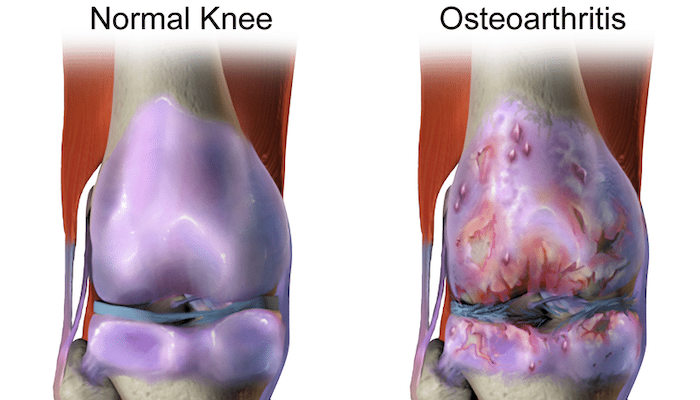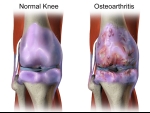
Knee osteoarthritis (OA) is a common condition that results in knee pain, inflammation, and stiffness. Various treatments are available, from heat and cold therapy, gentle exercises, and physical activity to medications and surgical interventions.
Osteoarthritis affects the cartilage in joints and is the most common type of arthritis, impacting approximately 32.5 million people in the United States. The knee is particularly vulnerable to OA, making everyday tasks like walking, climbing stairs, and performing routine activities difficult.
This guide will explore the causes, treatments, and lifestyle changes that can help manage knee osteoarthritis.
Causes of Knee Osteoarthritis
Knee OA is caused by the gradual wear and tear of the knee joint. Cartilage, the cushion that allows bones to move smoothly over each other, wears down over time. When the cartilage deteriorates, bones begin to rub together, leading to pain.
Risk factors for knee osteoarthritis include:
- Age: The risk increases with age, particularly after age 50.
- Gender: Women are more likely to develop knee OA than men.
- Occupation: Jobs that involve repetitive knee movements, such as bending or lifting, increase the risk.
- Injury: Previous knee injuries may raise the likelihood of developing OA.
- Body weight: Excess weight adds stress to the knee joint and may lead to joint inflammation.
- Genetics: Family history can increase the risk.
- Other health conditions: Metabolic diseases, joint issues, and bone irregularities may also contribute.
Symptoms of Knee Osteoarthritis
Symptoms of OA usually develop gradually and worsen over time. Common symptoms include:
- Stiffness after inactivity, especially in the morning.
- Swelling in the knee joint.
- Pain during movement or at rest.
- Limited range of motion, making it difficult to bend or straighten the knee.
- Crepitus, or a grinding noise in the joint.
- Joint instability, where the knee may feel like it could "give out."
- Knee locking, where the knee gets stuck in a bent or straight position.
- Bowed knees, a common symptom in advanced cases.
If these symptoms interfere with daily life, it’s important to consult a healthcare professional for evaluation.
Treatment Options for Knee Osteoarthritis
While there is no cure for knee OA, various treatments can help manage pain, improve mobility, and enhance quality of life. Diagnosis usually involves reviewing your medical history and conducting a physical examination.
Nondrug Treatments
Before opting for medication or surgery, doctors may suggest non-drug treatments to alleviate symptoms. These include:
- Cold therapy to reduce pain and swelling by limiting blood flow to the area.
- Heat therapy to improve circulation and reduce stiffness.
- Physical therapy to strengthen muscles around the knee, improving flexibility and range of motion.
- Alternative therapies like acupuncture or massage to enhance pain relief.
- Topical creams with ingredients like menthol, capsaicin, or CBD to reduce inflammation and pain.
- Weight loss to decrease stress on the knee and alleviate discomfort.
- Gentle exercise to promote blood flow and joint mobility.
- Tai chi to enhance balance and reduce the risk of falls.
- Assistive devices like braces or canes for easier movement.
Medications
Various medications can provide relief for knee OA. A healthcare provider will recommend the best treatment based on your symptoms and health history. Options include:
- Hyaluronic acid injections for direct pain relief in the knee joint.
- Over-the-counter pain relievers, such as NSAIDs like ibuprofen or naproxen.
- Topical NSAIDs in gel form applied directly to the knee.
- Prescription painkillers, such as COX-2 inhibitors like celecoxib.
- Corticosteroid injections to reduce pain and inflammation, with limitations on the frequency of use.
Surgical Options
When other treatments fail, surgery might be necessary. Surgical options include:
- Cartilage restoration, where healthy cartilage is grafted from another joint to replace worn cartilage.
- Osteotomy, where part of the shinbone or thighbone is reshaped to reduce pressure on the joint.
- Knee replacement, which can be either partial or total, replacing damaged joint parts with metal or plastic components.
Is Walking Beneficial for Knee Osteoarthritis?
Despite the pain and stiffness, walking and other low-impact exercises can be beneficial for those with knee OA. A 2022 study of individuals over 50 with knee OA found that regular walking led to less frequent pain. Walking might even slow the progression of the disease.
Other activities that can help include:
- Swimming
- Aqua aerobics
- Cycling
- Light gardening
Managing Life with Knee Osteoarthritis
In addition to medical treatments, lifestyle changes can help manage knee OA. These include:
- Avoiding triggers, like kneeling, squatting, or lifting heavy objects.
- Staying active with low-impact exercises like walking, swimming, and yoga to improve strength and flexibility.
- Weight loss to reduce the pressure on the knee joint.
- Cognitive Behavioral Therapy (CBT) for setting realistic exercise goals and maintaining a positive outlook.
Conclusion
Knee osteoarthritis occurs when cartilage in the knee joint deteriorates, causing the bones to rub together and result in pain, inflammation, and stiffness. It’s common in people who are aging, overweight, or engage in repetitive joint movements.
Treatment options range from at-home therapies to medications and surgery, and the best approach may vary from person to person. By combining medical treatment with lifestyle changes, you can effectively manage knee OA and improve your quality of life.
Precision Pain Care and Rehabilitation has two convenient locations in Richmond Hill – Queens, and New Hyde Park – Long Island. Call the Queens office at (718) 215-1888 or (516) 419-4480 for the Long Island office to arrange an appointment with our Interventional Pain Management Specialists, Dr. Jeffrey Chacko or Dr. Sonny Ahluwalia.













